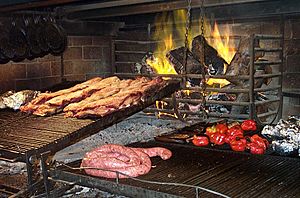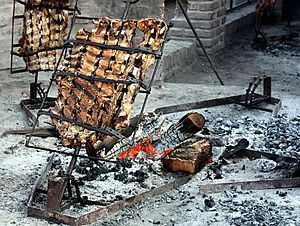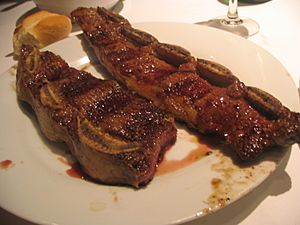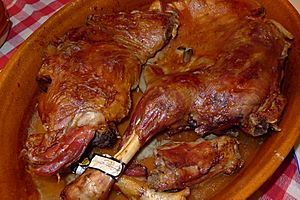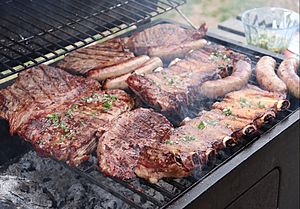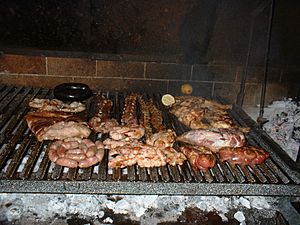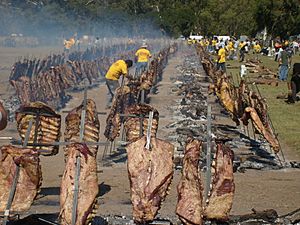Asado facts for kids
Asado is a special way of cooking meat over fire, and it's also the name for the fun social event where people gather to enjoy this meal. It's a very traditional barbecue in several South American countries, especially Argentina, Chile, Paraguay, and Uruguay. An asado usually includes different kinds of meat like beef, pork, and chicken. It also often features sausages like chorizo and morcilla (blood sausage). All these meats are cooked on an open fire or a grill called a parrilla. People often drink red wine and eat side dishes like salads with their asado. The person who cooks the meat is called the asador or parrillero.
Contents
History of Asado
Long ago, in the mid-1800s, many wild cattle roamed the pampa region of Argentina. The people living near the Río de la Plata, especially the skilled horsemen known as gauchos, loved beef. They particularly enjoyed asado, which means roasted beef, lamb, or goat.
Gauchos would skewer the meat, often a side of ribs, onto a metal frame called an asador. They would then roast it slowly next to a fire. They preferred using wood from the quebracho tree because it produced very little smoke. Asado, along with a traditional drink called mate, was a main part of the gaucho diet.
Cooking with Coal and Fire
The asador (cook) usually starts by lighting charcoal. This charcoal is often made from local trees. They avoid using pine or eucalyptus wood because these trees have strong-smelling resins that can affect the taste of the meat. For special asados, charcoal from specific trees or from recently burned wood might be used. In Uruguay, they often use direct embers or hot coals instead of charcoal.
There are two main ways to cook asado: al asador or a la parrilla.
- Al asador: A fire is made on the ground or in a pit. Metal crosses, also called asadores, are placed around the fire. A whole animal carcass is spread open on these crosses to cook from the heat of the fire.
- A la parrilla: A fire is made, and once the wood turns into hot charcoal, a grill with the meat is placed over it.
First Bites: Sausages and Organs
At many asados, certain items are served first while the main meat cuts are still cooking. These often include chorizos (sausages), morcillas (black pudding), chinchulines (cow intestines), and mollejas (sweetbreads). Sometimes, provoleta (grilled cheese) is also served. These first bites are often kept warm on a small charcoal heater called a brasero. Chorizos are often served with bread, creating a popular snack called choripán.
Main Meats and Sides
After the appetizers, the main meat cuts are served. These often include costillas or asado de tira (ribs). Other popular meats are vacío (flank steak), matambre (a thin cut of beef), and sometimes chicken or chivito (young goat). In restaurants, you might also find pamplona (rolled meat), pork, and Patagonian lamb.
An asado also includes bread and a simple mixed salad, often with lettuce, tomato, and onions. Sometimes, grilled vegetables called verdurajo are served. This mix of potatoes, corn, onion, and eggplant is cooked on the grill and seasoned with olive oil and salt. Drinks like beer, wine, and soft drinks are common. For dessert, fresh fruit is usually served.
Another traditional way to roast meat, especially in Patagonia, is called asado al palo. This involves cooking a whole animal, like lamb or pork, on a wooden stick stuck in the ground. The meat is exposed to the heat of live coals.
The meat for an asado is not usually marinated. The only preparation is adding salt before or during cooking. The cook carefully controls the heat and distance from the coals to ensure the meat cooks slowly, which usually takes about two hours. It's important that grease from the meat doesn't drip onto the coals and create smoke, as this can change the flavor of the meat. Sometimes, the area directly under the meat is kept clear of coals.
Once cooked, the asado is usually placed on a tray to be served right away. It can also be put on a brasero (a small table-top grill) to keep the meat warm while eating. Two popular sauces often served with asado are Chimichurri and salsa criolla.
- Chimichurri: Made from chopped parsley, dried oregano, garlic, salt, black pepper, onion, and paprika mixed with olive oil.
- Salsa criolla: A sauce made from tomato and onion in vinegar.
These sauces are traditionally used with the organ meats, but not usually with the steaks.
Salad Time
Salads are an important part of an asado. Traditionally, women prepare these salads at home or at the gathering while the men focus on cooking the meats. Salad Olivier (ensalada rusa) is a very common salad served at asados. In Paraguay, side dishes like chipa guasu, sopa paraguaya, and boiled manioc are also served.
Asado Variations
In Chile, a common variation is cordero al palo, which is a whole roast lamb. It's often served with pebre, a local sauce similar to chimichurri made from pureed herbs, garlic, and hot peppers. This dish is popular in southern Chile and is served hot with salads. A whole lamb is tied to a spit and roasted over a wood fire. This cooking process takes about 5 hours because it needs constant, low heat.
In Brazil, asado is called churrasco, and the cooking is usually faster. Grilled and salted meat in Brazil is often called "carne assada." It's usually cut into small strips and served on a plate in the middle of the table for everyone to share. In a "rodizio" style churrasco, different grilled meats, pork, sausages, and sometimes chicken are brought around on a spit, and a slice is offered to each person. Brazilians mostly use charcoal instead of wood embers, and they tend to cook meat on skewers or grills. The meat in a rodizio is usually seasoned only with salt.
In Mexico, there's a similar tradition called parrilladas or carne asadas. These include various marinated meats like steaks, chicken, and sausages (chorizo, longaniza, and moronga are popular). All are grilled over wood charcoal. Vegetables like green onions (cebollitas), nopales (cactus pads), and corn (elote) are also grilled.
In Argentina, Uruguay, and Paraguay, you might find other ways of cooking asado, especially in the countryside. These include asado al disco and asado al horno de barro.
- Asado al disco: This uses an old plough disc. It's metallic and curved, with three or four legs welded to it. With hot coals or wood underneath, it becomes an effective grill. Food is placed in a spiral, so the fat naturally drips to the center, keeping the meat from frying. Bell peppers and onions are often placed near the edge to slowly release their juices onto the meat.
- Asado al horno de barro: This method uses an adobe oven, called a horno (or tatakua in Paraguay). These ovens are common on Argentine and Paraguayan estancias (ranches). Their main job is to bake bread, chipa guasu, and sopa paraguaya, but they are also great for roasting meat. Young pork and, less often, lamb are served this way, as they are less likely to dry out.
Another way to cook asado is inside a chulengo. This is usually an oil barrel cut in half, with the grill placed inside. This protects the meat and fire from strong winds, making it very useful in Patagonia, though it's also used elsewhere for convenience.
Similar Terms in Other Cuisines
It's important not to confuse South American asado with the term asado in the Philippines. In the Philippines, asado refers to two different braised (slow-cooked in liquid) dishes:
- Asado de carajay: Braised meat with vegetables in a savory stew.
- Pork asado: A sweet, braised version of char siu (Chinese barbecue pork).
The closest thing to Latin American barbecue in Philippine cooking would be dishes called inihaw (also known as sinugba or inasal).
In Portugal, a roasted fish dish served with sausages and bacon is also known as assado. In Goa, a type of roast beef is called assad, which comes from the Portuguese word assado. In South Africa, a whole meat carcass cooked using the al asador method is called an asado spit braai or spit roast.
See Also
 In Spanish: Asado para niños
In Spanish: Asado para niños


